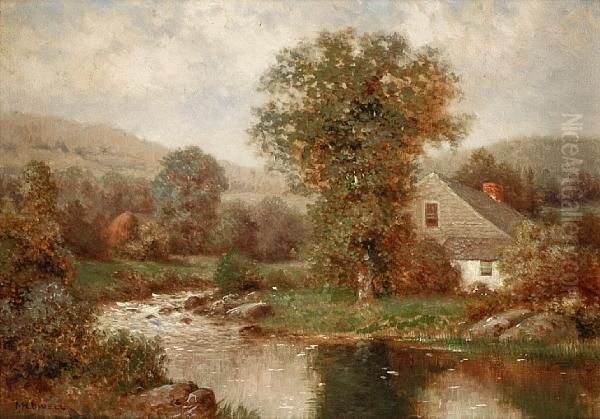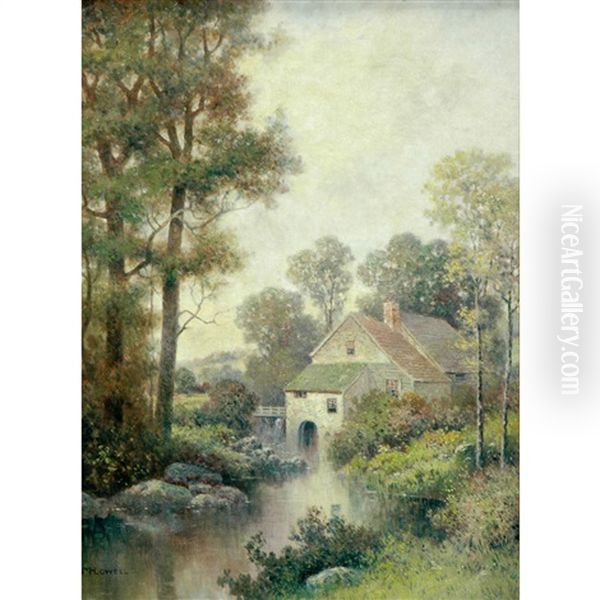Milton H. Lowell (1848-1927) was an American artist who dedicated his career primarily to landscape painting. Active during a transformative period in American art, his life spanned the waning years of the Hudson River School's dominance, the rise of Tonalism and American Impressionism, and the burgeoning of modern art movements. While not as widely celebrated today as some of his contemporaries, Lowell's work offers a glimpse into the artistic sensibilities of his time, particularly the enduring appeal of the American landscape.
Early Life and Artistic Genesis
Born in Cambridge, Massachusetts, in 1848, Milton H. Lowell grew up in a region rich with artistic and intellectual ferment. New England, and Cambridge in particular, was a crucible of American thought and culture, home to literary giants and a burgeoning appreciation for the arts. The mid-19th century saw the Hudson River School artists frequently venturing into New England to capture its pastoral beauty and rugged coastlines. Figures like Frederic Edwin Church and John Frederick Kensett were already established, and their detailed, often romanticized depictions of nature set a high bar for landscape art.
The provided information suggests Lowell's artistic journey may have begun after a period working with his father, followed by a role in the art department of the "Courier-Citizen." This practical experience, common for many artists of the era who often started in commercial art or illustration, could have provided him with foundational skills in drawing and composition before he fully dedicated himself to fine art painting. His birthplace in Cambridge and eventual passing in Boston in 1927 firmly root him within the New England artistic milieu.
Artistic Focus: The New England Landscape
Lowell is noted as a landscape painter, and his known works, such as "New England Landscape" and "Along the Stream," confirm this dedication. The New England landscape, with its varied seasons, rolling hills, dense woodlands, and meandering waterways, offered endless inspiration. Artists of Lowell's generation were heirs to a tradition that viewed the American landscape not just as a picturesque subject but also as a source of national identity and spiritual solace.

His signature, documented as "M H Lowell" or the conjoined "MHLowell (ll)," is a crucial marker for attributing works. The painting "Along the Stream," an oil on canvas, specifically bears this latter signature form. This piece, having appeared at auction at Doyle New York, provides a tangible example of his output. While detailed stylistic analyses of his broader oeuvre are scarce in readily available records, his commitment to landscape aligns him with a significant current in American art.
The Artistic Environment: Contemporaries and Influences
Milton H. Lowell's career unfolded amidst a dynamic and evolving American art scene. When he was beginning his artistic endeavors, the influence of the Hudson River School, with its emphasis on detailed realism and often majestic portrayals of nature, was still palpable. Artists like Albert Bierstadt, known for his grand Western landscapes, and Sanford Robinson Gifford, a master of Luminism with its ethereal light, were prominent. The meticulous approach of earlier figures such as Asher B. Durand and the philosophical underpinnings provided by Thomas Cole had laid a strong foundation for landscape painting in America.
As Lowell matured, new artistic currents arrived from Europe, notably Barbizon-influenced Tonalism and Impressionism. Tonalism, championed in America by artists like George Inness and Dwight William Tryon, favored mood, atmosphere, and a more subjective interpretation of the landscape, often rendered in a limited palette of harmonious tones. James McNeill Whistler, though largely based in Europe, also became a towering figure whose Tonalist aesthetics had a profound impact. It is plausible that Lowell's work might have absorbed some of these Tonalist sensibilities, particularly if "Along the Stream" or "New England Landscape" evoke a more poetic or intimate mood rather than grand spectacle.
By the later part of Lowell's career, American Impressionism was in full swing. Artists like Childe Hassam, John Henry Twachtman, and J. Alden Weir adapted French Impressionist techniques to American subjects, focusing on light, color, and capturing fleeting moments. Many American Impressionists, such as Willard Metcalf and Frank Weston Benson, also found rich subject matter in the New England landscape. While there's no direct evidence linking Lowell to Impressionism, the pervasive influence of this movement on landscape painters of his time cannot be discounted. He may have incorporated brighter palettes or looser brushwork in his later works, or he might have remained more aligned with earlier realist or Tonalist traditions.
Orson Lowell: A Son in the Arts

An interesting dimension to Milton H. Lowell's story is his son, Orson Lowell (1871-1956), who became a renowned American illustrator and cartoonist. Orson's success provides a fascinating glimpse into the artistic environment of the Lowell family. Orson studied at the Art Institute of Chicago, a prominent institution, and later established his career in New York. He was a founding member of the Society of Illustrators, served as president of the Guild of Free Artists, and was a member of the New Rochelle Art Association, also having connections with the New Rochelle Public Library.
The source material mentions that Orson Lowell was often compared to Charles Dana Gibson, the creator of the iconic "Gibson Girl" and one of the most celebrated illustrators of the era. This comparison underscores Orson's standing in the field. The "Golden Age of Illustration" in America, roughly from the 1880s to the 1920s, saw illustrators like Howard Pyle and N.C. Wyeth achieve widespread fame and influence. Orson Lowell's participation in this vibrant field suggests that artistic pursuits were valued and perhaps encouraged within Milton H. Lowell's family. While Milton focused on landscape painting, his son's foray into illustration highlights the diverse avenues available to artists at the turn of the 20th century.
Exhibitions, Recognition, and Legacy
The primary documented exhibition or public appearance of Milton H. Lowell's work mentioned is the auction of "Along the Stream" at Doyle New York. For many artists of the 19th and early 20th centuries who were not part of the most elite circles or whose estates were not meticulously managed, records of exhibitions can be sparse. They might have exhibited locally, in regional art association shows, or with commercial galleries whose records are no longer easily accessible.
The mention of Lowell potentially being involved in landscape architecture, including designs for significant buildings like the Boston Museum of Fine Arts and the New York County Courthouse, is intriguing. However, this information requires careful consideration, as the architect primarily associated with the Boston Museum of Fine Arts' early 20th-century design was Guy Lowell, a different and very prominent member of the Lowell family. It is possible there's a conflation here, or Milton H. Lowell had a more modest, perhaps advisory or landscape-specific role that is less documented. Without further corroborating evidence, his primary identification remains as a landscape painter.
The challenge in reconstructing the careers of artists like Milton H. Lowell lies in the historical record, which tends to favor those who achieved national or international fame, were associated with major art movements, or whose works were acquired by prominent museums during or shortly after their lifetimes. Many competent and dedicated artists contributed to the richness of their local and regional art scenes without achieving widespread posthumous recognition.
Milton H. Lowell's work, as exemplified by titles like "New England Landscape" and "Along the Stream," places him within the enduring tradition of American landscape painting. He practiced his art during a period of significant stylistic evolution, from the detailed realism of the Hudson River School to the atmospheric concerns of Tonalism and the light-filled canvases of Impressionism. His contemporaries included a wide array of talented individuals who explored the American scene in diverse ways, from the epic vistas of Thomas Moran to the intimate marine paintings of Alfred Thompson Bricher or the pastoral scenes of Winslow Homer (who also masterfully depicted the New England coast).
Understanding Lowell in Context
To appreciate Milton H. Lowell, one must consider the artistic ecosystem of his time. The late 19th century saw an increase in art schools, galleries, and collectors in America. Artists often traveled between Boston, New York, and Philadelphia, and many sought training or exposure in Europe, particularly Paris or Munich. Whether Lowell undertook such European study is not specified, but the influences of European art were certainly felt throughout the American art world.
His focus on New England aligns him with a long lineage of artists captivated by the region. From the early portraitists to the grand landscapists and later the Impressionists who flocked to art colonies in places like Old Lyme, Connecticut (home to the Florence Griswold Museum and artists like Childe Hassam), New England has been a perennial muse. Lowell's contribution, however modest it might appear next to more famous names, is part of this larger narrative. Each artist who depicted the streams, forests, and fields of New England added a personal inflection to this collective artistic vision.
The very act of painting "Along the Stream" suggests an interest in the intimate, accessible aspects of nature, rather than necessarily the sublime or the monumental that characterized some earlier Hudson River School works. Such a subject could lend itself to a quiet, reflective Tonalist approach or a more direct, naturalistic rendering. Without viewing a significant body of his work, it is difficult to definitively categorize his style, but his chosen subjects are indicative of a deep connection to his regional environment.
Conclusion: A Quiet Contribution to American Art
Milton H. Lowell represents one of the many dedicated artists who contributed to the fabric of American art in the late 19th and early 20th centuries. As a New England landscape painter, he worked within a cherished tradition, capturing the beauty of his native region. While the historical record, as presented, offers limited specific details about his stylistic evolution or the full scope of his career, his existence and documented works like "Along the Stream" and "New England Landscape" ensure his place, however small, in the annals of American art.
His life, framed by his birth in Cambridge and death in Boston, and his active years as an artist, position him as a witness to and participant in a period of profound change in American art and culture. The success of his son, Orson Lowell, in the competitive field of illustration further hints at a family environment where artistic talent was nurtured. Milton H. Lowell's legacy, like that of many artists of his era, may lie less in groundbreaking innovation and more in the sincere and skilled depiction of the landscapes that defined his world, contributing to the rich tapestry of American regional painting. Further research into local Massachusetts exhibition records or family archives might one day shed more light on this New England artist.